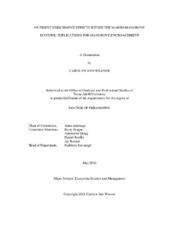| dc.description.abstract | Over the past two centuries, woody vegetation has expanded globally in coverage, often encroaching into grasslands, including coastal habitats. Mangroves are tropical trees which are susceptible to freezing temperatures. Therefore, the frequency and severity of freezing events are often invoked as the main control in mangrove growth and distribution within the sub-tropical marsh-mangrove ecotone. However, as freezing events have occurred less frequently, mangrove coverage has increased within these regions, often encroaching into salt marsh habitats. Other factors may also influence plant composition within this ecotone by either perpetuating mangrove encroachment, or conversely, favoring salt marsh vegetation and the subsequent suppression of mangrove establishment and growth. Salt marsh and mangrove systems are exposed to anthropogenic nutrient enrichment which may be an additive factor to temperature-driven vegetation changes. Many studies have documented positive nutrient responses within both marsh and mangrove monotypic stands, but few studies have examined nutrient dynamics in mixed stands. In order to assess the impact of nutrient addition on herbaceous and woody plant composition within a marsh-mangrove ecotone, I fertilized in situ mixed stands of Spartina alterniflora (smooth cordgrass) and Avicennia germinans (black mangrove), two dominant species within the Northern Gulf of Mexico, for four growing seasons (2010 – 2013). Overall, I hypothesized that nutrient enrichment would augment growth more so in S. alterniflora than in A. germinans, facilitating salt marsh vegetation dominance and conversely slowing mangrove encroachment.
Contrary to what I expected, my results suggest that nutrient enrichment promoted A. germinans growth, which could subsequently lead to accelerated mangrove stand expansion and subsequent displacement of S. alterniflora. Nearly all A. germinans plant metrics were significantly elevated between control and fertilized plots, indicating that nutrient enrichment facilitated growth in A. germinans. Conversely, S. alterniflora plant metrics had very little response to nutrient enrichment. Collectively, these data indicate that A. germinans growth was facilitated by nutrient enrichment, whereas fertilization responses were diminished with S. alterniflora metrics. More specifically, mangrove height distribution significantly increased within fertilized plots, augmenting its ability to displace neighboring marsh plants. These results suggest, contrary to previous studies, A. germinans growth may benefit more from nutrient enrichment than S. alterniflora in the marsh-mangrove ecotone. Although nutrient enrichment is not the main factor driving mangrove encroachment, fertilization may be perpetuating the increase in mangrove coverage and accelerating marsh displacement. Therefore, nutrient enrichment can be considered a positive feedback for mangrove stand expansion, as it can further propel climate-driven woody encroachment within the marsh-mangrove ecotone. It is important to identify and understand factors serving as feedbacks in order to better predict how ecosystem components will be influenced in various global change scenarios. Areas within the marsh-mangrove ecotone that have higher potential for anthropogenic nutrient enrichment could be more susceptible to mangrove encroachment and management strategies may need to be prioritized, because a shift from marsh to mangrove vegetation could have large implications for a variety of ecosystem services. | en |


